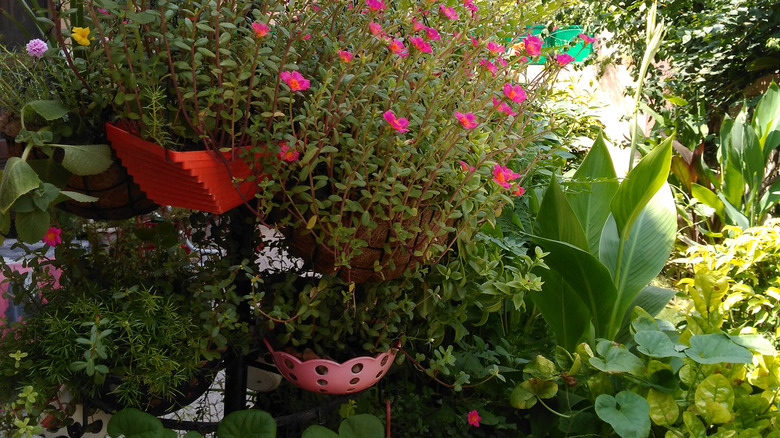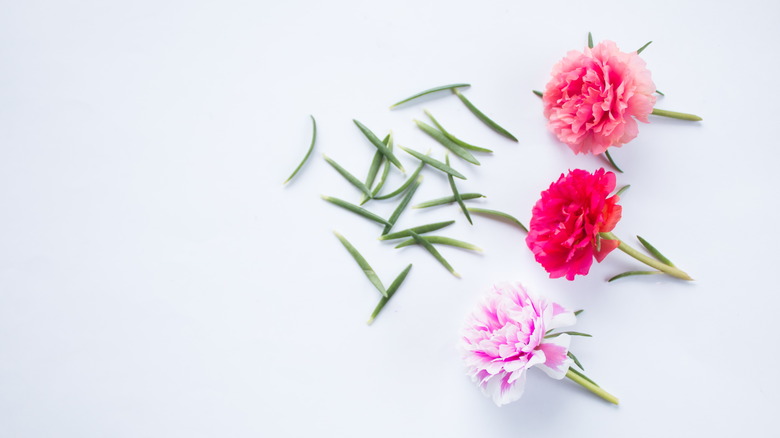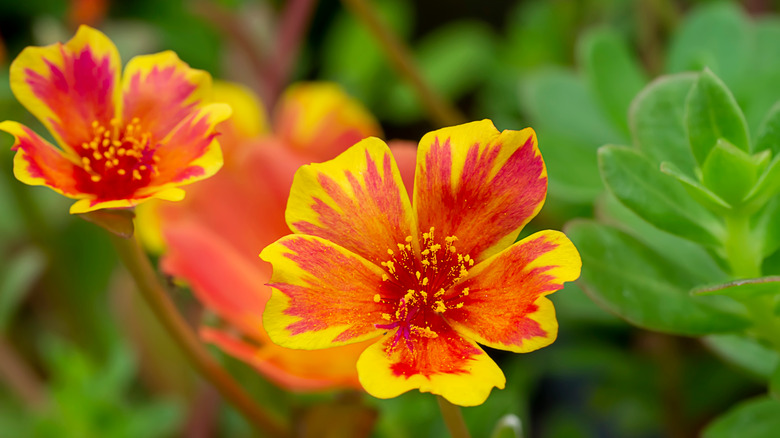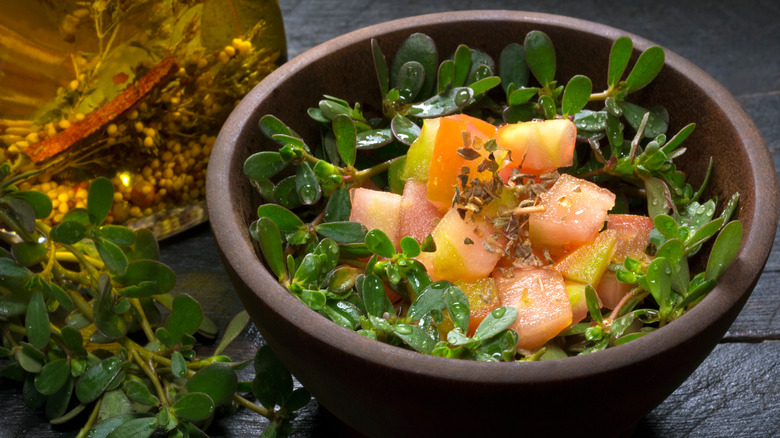How To Successfully Grow Portulaca Plants
Adored by chickens, cultivated medicinally around the world for eons, and a favorable ground cover used by many home gardeners, the portulaca is an easy to care for plant with over 100 varieties. Portulaca grandiflora, pictured above, is one of the most commonly found variations, and is often referred to as moss rose, or sun plant. It has succulent leaves, which make it drought tolerant (by retaining water), and its small flowers come in a wide range of bright colors that keep blooming from summer to fall. Portulaca branches stand out with a reddish tint and those succulent leaves are slim with a dark green hue.
Portulaca oleracea, on the other hand, is often considered a very difficult to get rid of weed referred to as purslane. The University of Illinois Extension likens this other commonly seen variation to a small jade plant bearing yellow flowers. Yet, where some gardeners may consider purslane nothing more than a pesky weed, some culinary enthusiasts see it as a delicacy. Purslane can be found in dishes from some of the best five-star restaurants, like Dan Silverman's Standard Grill (via New York magazine), as well as recipes from notable publications such as Food & Wine.
How to use portulaca plants in garden
The Spruce offers a slew of ways to integrate these bright, happy plants into your garden or larger landscape design. Over the course of one season they can spread enough to make a wide, thick mat that covers an entire garden floor, thus protecting the soil below. Because of this, The Spruce also puts them at the top of their list of best succulents to use for ground cover. Per Better Homes & Gardens, they are also deer resistant. So, consider using Portulaca grandiflora plants (the multi-colored and less weed-like variety) to create a visually attractive border that may help keep those hungry trespassers at bay.
Portulaca flowers make a fantastic addition to outdoor containers and hanging baskets because of their ability to trail and fall over the sides where they will hang down. These tough and fast growers are also known to sprout up between rocks and pavement cracks. If you're looking for a pop of color to brighten up an otherwise drab rock wall or garden, adding portulaca is a no brainer.
How to grow portulaca plants
Better Homes & Gardens points out a very important factor when growing portulaca: location, location, location. Full sun is necessary, up to six hours per day. Dry, sandy soil is much preferred over any area that may stay wet. Per Gardening Know How, the root systems of the portulaca remain shallow and their leaves retain water, meaning plants require little additional watering. It's these succulent properties of the portulaca's leaves that make the plants drought tolerant and easy to grow, yet that's also what puts them at risk for accidental overwatering when grown in the company of others.
New plants can be started indoors as seedlings but don't need to be. Simply spreading the seeds around your garden by hand will result in healthy seedlings just as quickly. There's no need to cover these seeds, either. Direct sun exposure is more important when it comes to encouraging new growth.
For the gardener with less time on their hands, portulaca plants are a great option because they actually reseed themselves regularly and will continue to spread. Since you may find flowers growing in the ground under your hanging baskets from last year's fallen seeds, Gardening Know How seconds the tip to think carefully about where you place them, adding that, if anything, you may end up cutting them back. Left to their own devices, they have the potential to become invasive. Another popular option for easily propagating portulaca is through stem cuttings planted in well-draining soil.
How to care for portulaca plants
As mentioned above, the most important aspects of portulaca care are low moisture and full sun exposure. Wet soil is one of the only ways to kill this incredibly hardy plant. And sunshine is so important that, according to NC State's Extension Garden Plant Toolbox, portulaca flowers close up overnight and will stay shut on an overcast day. Keep your plants out of the shade, and you should have no problem convincing the bright blooms to reopen every morning and say hello. Provided these conditions are met, portulaca plants need little to no further attention.
The portulaca is very much an outdoor plant and does not fare well indoors in pots, nor does it take kindly to being transplanted. Yet it can perform very well in outdoor container gardens. Additionally, sometimes removing portulaca is more important than caring for it. Its tendency to continue spreading, even when grossly neglected, can turn even the Portulaca grandiflora from a pleasant flower into a difficult to manage weed. Gardening Know How explains that while you can easily rip all of your portulaca out of the ground by hand, it's nearly impossible to rid your garden of its seeds and stems. The mother plant throws seeds a fair distance and this incredible force of nature can even regrow itself from a tiny piece of stem left on the ground. Talk about a survivor! Tips for true removal include thick mulch covering to block sunlight, herbicides, and proper disposal.
Portulaca plant varieties
With over 100 varieties to choose from, you'll find portulaca flowers in all sorts of colors.
- Flowers of the Portulaca umbraticola, also called wingpod purslane, can be red, pink, or orange. Specialty flower site Proven Winners even has a yellow variety available.
- The Sundial variation of Portulaca grandiflora is growing in popularity. As noted by Garden Guides, this is likely because its flowers can flourish with less sun exposure than most other portulaca plants.
- Portulaca Calypso, Bodhigyel, Duet, and Yubi Summer Joy are all human-made cultivars featuring their own bright blooms in a range of sunset hues.
- Portulaca oleracea, pictured above, is the go-to edible option for those fancy salad green mixes
- Per Healthline, the leaves of this edible variety are not only tasty but high in nutrients such as vitamin C, manganese, and iron.
- Rustic Wise compares the flavor of this green to a juicy cucumber, albeit one with a bit of bite.
From weed to uplifting flower to healthy green to medicinal staple, the portulaca comes in many forms for gardeners, chefs, and herbalists alike.
Are portulaca plants toxic?
The portulaca plant has two very different presentations when it comes to toxicity. If consumed by cats, all parts of this plant are considered toxic due to their soluble calcium oxalates, which felines are unable to digest. According to the nationwide pet care community Wag!, signs of portulaca poisoning will first show up as salivating and general discomfort around the mouth. This is often enough to discourage your cat from eating more, but don't wait for further symptoms to develop before getting your furry friend to the vet's office, because calcium oxalate crystals in the digestive tract will move to the kidneys. That's where symptoms can worsen quickly. In extreme cases, renal tubular necrosis and kidney failure have occurred. Portulaca is not recommended for use in any garden where outdoor cats are present.
For humans, on the other hand, portulaca is quite the opposite of toxic. All varieties are considered edible and the Portulaca oleracea in particular has been cited by Science Direct as a well-known medicinal relied upon all over the world. Most popular in tropical and subtropical regions, this plant is used in the treatment of a host of gastrointestinal disorders, as well as respiratory issues, fevers, and headaches. Throughout the bulk of human history some of the most prominent names in the field of pharmacology have written about the benefits of this revered plant. This includes Dioscorides, a Greek physician who lived from 40 to 90 CE.
Portulaca plant uses
Chickens love portulaca too! In addition to its edibility for humans and wide ranging medicinal applications, the common purslane variety of portulaca makes a great addition to your chicken feed. Per Raising Happy Chickens, Portulaca oleracea as a dietary supplement benefits not only the chickens themselves, but the humans who then consume their eggs. In a study published by the Journal of the Science of Food and Agriculture, purslane was proven to raise omega-3 fatty acid levels in these egg yolks. Chickens will gladly eat the entire plant, stems, flowers, and all. There are no associated issues with purslane as chicken feed, but you'll want to keep the quantity supplemental and never rely on it as their only food.
If you already have it planted in your garden, you can simply break off bits from a healthy branch and leave it on the ground for your hens to devour, or consider planting it inside your fenced off coop area where they can pick at it at will. If the exciting potential of omega-3 boosted eggs is news to you, then your soon-to-be-very-happy chickens are likely eager for you to get some portulaca in the ground soon.






